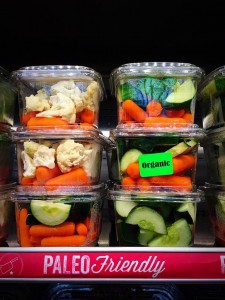Latest in supermarket marketing: Paleo friendly

Thanks to Andy Bellatti for noticing this at his local Las Vegas Whole Foods.
This reminds me so much of the Low-Carb craze way back in 2005.

Oh well. Whatever works.


Thanks to Andy Bellatti for noticing this at his local Las Vegas Whole Foods.
This reminds me so much of the Low-Carb craze way back in 2005.

Oh well. Whatever works.
Let me start with a reminder that since mid-March I’ve been collecting examples of studies funded by food companies or trade associations that come up with results favorable to the sponsor’s interests. I post them five at a time. I am having a hard time finding industry-funded studies that do not favor the sponsor’s interests. If you run across any, please send. Here’s the latest collection.
Mediterranean Diet and Invasive Breast Cancer Risk Among Women at High Cardiovascular Risk in the PREDIMED Trial: A Randomized Clinical Trial. Estefanía Toledo, MD, MPH, PhD; Jordi Salas-Salvadó, MD, PhD; Carolina Donat-Vargas, PharmD; et al. JAMA Intern Med. Published online September 14, 2015. doi:10.1001/jamainternmed.2015.4838
Evaluation of 4-methylimidazole, in the Ames/Salmonella test using induced rodent liver and lung S9 Carol Beevers1,* and Richard H. Adamson. Environ. Mol. Mutagen., Article first published online: 10 SEP 2015. DOI: 10.1002/em.21968.
Reduced Symptoms of Inattention after Dietary Omega-3 Fatty Acid Supplementation in Boys with and without Attention Deficit/Hyperactivity Disorder. Dienke J Bos, Bob Oranje, E Sanne Veerhoek, Rosanne M Van Diepen, Juliette MH Weusten, Hans Demmelmair, Berthold Koletzko, Monique GM de Sain-van der Velden, Ans Eilander, Marco Hoeksma, and Sarah Durston. Neuropsychopharmacology. 2015 Sep; 40(10): 2298–2306. Published online 2015 Apr 22. doi: 10.1038/npp.2015.73.
Milk Modulates Campylobacter Invasion into Caco-2 Intestinal Epithelial Cells. Rogier Louwen, R. J. Joost van Neerven. European Journal of Microbiology and Immunology 5 (2015) 3, pp. 1–7 2015. doi:10.1556/1886.2015.00019.
Effect of the probiotic strain Bifidobacterium animalis subsp. lactis, BB-12®, on defecation frequency in healthy subjects with low defecation frequency and abdominal discomfort: a randomised, double-blind, placebo-controlled, parallel-group trial. Dorte Eskesen, Lillian Jespersen, Birgit Michelsen, Peter J. Whorwell, Stefan Müller-Lissner and Cathrine M. Morberg. British Journal of Nutrition. DOI: http://dx.doi.org/10.1017/S0007114515003347 , 9 pages. Published online: 18 September 2015.
Sunday’s New York Times carried this full-page advertisement.
The ad is from Cocoa Via, a company owned by Mars. It quotes a dietitian stating that cocoa flavanols “support healthy blood flow…which allows oxygen and nutrients to get to your heart more easily.”
The ad directs you to the full story at nytinmes.com/cocoavia (where you see more ads).
I posted the science behind this ad earlier this month in my collection of industry-funded studies with results favorable to the sponsor’s interests. To repeat:
Cocoa flavanol intake improves endothelial function and Framingham Risk Score in healthy men and women: a randomised, controlled, double-masked trial: the Flaviola Health Study. Roberto Sansone, Ana Rodriguez-Mateos , Jan Heuel, David Falk, Dominik Schuler, Rabea Wagstaff, Gunter G. C. Kuhnle, Jeremy P. E. Spencer, Hagen Schroeter, Marc W. Merx, Malte Kelm and Christian Heiss for the Flaviola Consortium, European Union 7th Framework Program. British Journal of Nutrition, September 9, 2015. doi:10.1017/S0007114515002822.
Now we have a full-page ad in the New York Times.
Here’s what the ad does not say:
Like most conflicted research, this is about marketing—hence, the ad—not science.
Really, the Dietary Guidelines Advisory Committee’s (DGAC) report shouldn’t be this controversial and shouldn’t be controversial at all (as I’ve said before). But lots of people—the food industry, of course, but also some scientists and journalists—seem to have exceptionally intense opinions about the fat recommendations [Recall: The DGAC report does not constitute the Dietary Guidelines; these are written by USDA and HHS and are not due out until the end of this year].
Now, we have the journalist Nina Teicholz, author of The Big Fat Surprise, repeating the themes of her book in the BMJ: The scientific report guiding the US dietary guidelines: is it scientific?.
The BMJ has also found that the committee’s report used weak scientific standards, reversing recent efforts by the government to strengthen the scientific review process. This backsliding seems to have made the report vulnerable to internal bias as well as outside agendas.
Teicholz’s interpretation of the science relating dietary fat to health has been thoroughly critiqued (see end of post). The way I see it, these arguments are difficult to resolve outside the context of dietary patterns as a whole.
My hypothesis (note: hypothesis) is that for people who balance calorie intake with expenditure, the type of fat—or carbohydrate—matters much less than it does for people who overeat calories. This hypothesis needs testing to confirm it.
What troubles me about Teicholz’s work is the certainty with which she presents her ideas. She comes across as utterly convinced she is right, even in the face of substantial and substantive criticism of her statements and interpretations.
At least one error
Here, for example, is one statement in the BMJ article that I know from personal experience cannot be correct.
Much has been written about how industries try to influence nutrition policy, so it is surprising that unlike authors in most major medical journals, guideline committee members are not required to list their potential conflicts of interest.
I was a member of the 1995 DGAC and I was required to declare conflicts of interest. So were members of the committees in 2000, 2005, and 2010, as shown in this excellent short video.
Later, discussing conflicts of interest among DGAC members, Teicholz says:
Still, it’s important to note that in a field where public research dollars are scarce, nearly all nutrition scientists accept funding from industry. [Nearly all? I don’t, and I doubt this is correct]. Of far greater influence is likely to be bias in favor of an institutionalized hypothesis as well as a “white hat” bias to distort information for what is perceived as righteous ends.
The “white hat bias” comment refers to a paper by authors who themselves report food-industry funding:
Competing Interests. Drs. Allison and Cope have received grants, honoraria, donations, and consulting fees from numerous food, beverage, dietary supplement, pharmaceutical companies, litigators, and other commercial, government, and nonprofit entities with interests in obesity and nutrition including in interests in breastfeeding and NSBs. Dr. Cope has recently accepted a position with The Solae Company (St Louis, MO.).
Responses to the BMJ article
The DGAC wrote a rebuttal to Teicholz. It is published on the BMJ website.
HHS also published a statement, reproduced by Mother Jones.
The British Medical Journal’s decision to publish this article is unfortunate given the prevalence of factual errors. HHS and USDA required the 2015 Dietary Guidelines Advisory Committee to conduct a rigorous, systematic and transparent review of the current body of nutrition science. Following an 19-month open process, documented for the public on DietaryGuidelines.gov, the external expert committee submitted its report to the Secretaries of HHS and USDA. HHS and USDA are considering the Scientific Report of the 2015 Dietary Guidelines Advisory Committee, along with comments from the public and input from federal agencies, as we develop the 2015 Dietary Guidelines for Americans to be released later this year.
Yoni Freedhoff’s Weighty Matters blog provides a handy summary of additional responses to the BMJ article.
Scientific analysis of The Big Fat Surprise
Many of the scientific claims in this book seemed so far-fetched that they induced a nutritionist, Seth Yoder, to go over it line by line, read the references, and point out discrepancies. These are posted on his website in two parts.
A summary quote from Part 1:
What makes this particular book interesting is not so much that it is bad (which it is) or that it is extravagantly biased (which it also is). No, what really fascinates me about this book is that the author excessively and shamelessly lifts other people’s material.
And a quote from Part 2
The Big Fat Surprise (BFS) by Nina Teicholz is yet another book in a long line of books that informs the reader that everything you thought you knew about nutrition is wrong: saturated fat from animals is actually quite good for you, cholesterol isn’t really important, the government lied to you, nutritionists and dietitians lied to you, the American Heart Association lied to you, etc… Leaving aside that the concept of that kind of a conspiracy actually existing is really absurd, what I’m surprised about is that publishers can keep churning out books like this and people are gullible enough to keep buying them.
Caveat emptor.
Additions:
Here’s a sweet conclusion to this week’s sugar theme (#5):

How do bakeries do this? I have no idea.
But this particular bakery at first refused to make the cake.
It worried about potential copyright violation (I’m not kidding).
Well, it’s too late to sue. The evidence has been consumed.
This week’s post about sugars #4:
Sugar politics is in the news and I’ve been collecting items about it.
This week’s sugar item #3
John Downs, the president of the National Confectioners Association has an editorial (note: sponsored) in Politico announcing the NCA’s new campaign to convince Americans of the benefits of eating candy.
Candy is a special treat that has played an important role in cultural traditions, seasonal celebrations and family occasions here in the U.S. and around the world. But some consumers might not know that there is much more that goes into this honest, affordable, fun and transparent treat.
What more? The economic benefits, of course. Here’s the Infographic:

The press release highlights the benefits.
The confectionery industry directly employs 55,000 people in the United States, and more than 400,000 jobs in agriculture, retail, transportation and other industries rely in part on the sale of confections for their livelihood. For every job that is created in confectionery another seven are supported in related industries, which means that candy drives a multiplier effect of 1:7 or an impact of 700 percent.
Sugar? Calories? Tooth decay? Obesity?
Never mind.
Sugars item #2 for this week (about half of the sugars in US diets come from sugar-sweetened beverages)
As promised in his op-ed in the Wall Street Journal in August, Muhtar Kent, the CEO of Coca-Cola, is making its funding transparent. He said he “directed Sandy Douglas, president of Coca-Cola North America, to”
Publish on our website a list of our efforts to reduce calories and market responsibly, along with a list of health and well-being partnerships and research activities we have funded in the past five years, which we will continue to update every six months.
True to his word, here is Coca-Cola’s commitment to transparency:
This makes interesting reading, to say the least. Enjoy!